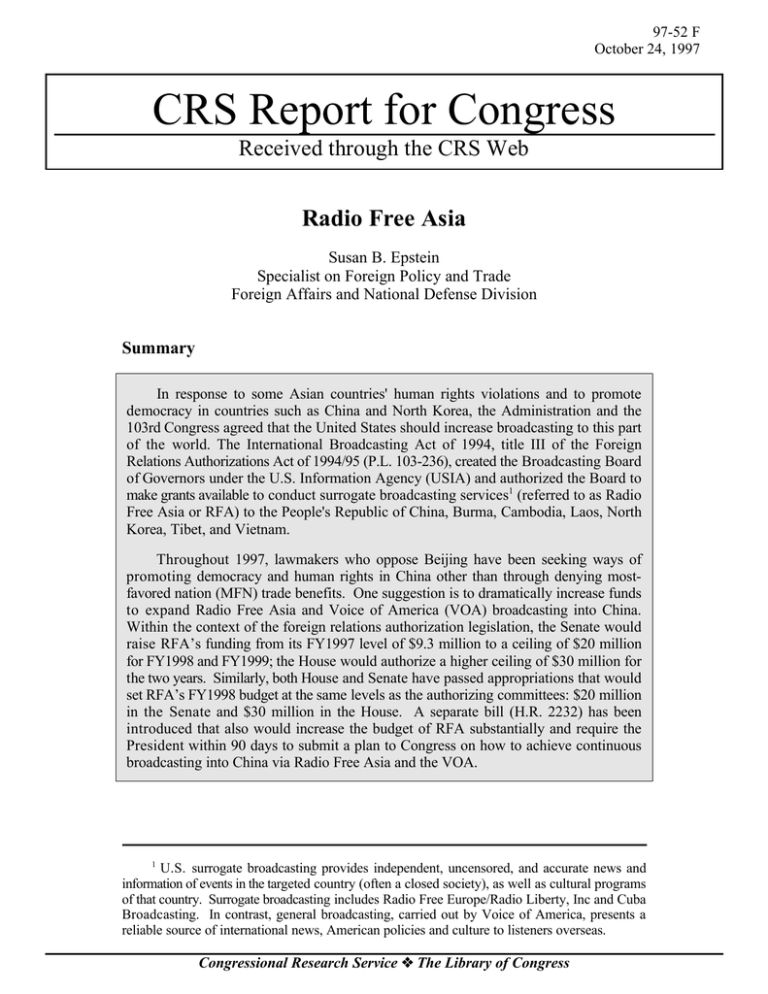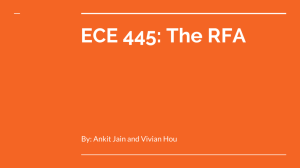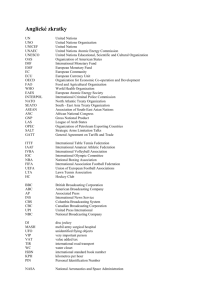CRS Report for Congress Radio Free Asia Received through the CRS Web Summary
advertisement

97-52 F October 24, 1997 CRS Report for Congress Received through the CRS Web Radio Free Asia Susan B. Epstein Specialist on Foreign Policy and Trade Foreign Affairs and National Defense Division Summary In response to some Asian countries' human rights violations and to promote democracy in countries such as China and North Korea, the Administration and the 103rd Congress agreed that the United States should increase broadcasting to this part of the world. The International Broadcasting Act of 1994, title III of the Foreign Relations Authorizations Act of 1994/95 (P.L. 103-236), created the Broadcasting Board of Governors under the U.S. Information Agency (USIA) and authorized the Board to make grants available to conduct surrogate broadcasting services1 (referred to as Radio Free Asia or RFA) to the People's Republic of China, Burma, Cambodia, Laos, North Korea, Tibet, and Vietnam. Throughout 1997, lawmakers who oppose Beijing have been seeking ways of promoting democracy and human rights in China other than through denying mostfavored nation (MFN) trade benefits. One suggestion is to dramatically increase funds to expand Radio Free Asia and Voice of America (VOA) broadcasting into China. Within the context of the foreign relations authorization legislation, the Senate would raise RFA’s funding from its FY1997 level of $9.3 million to a ceiling of $20 million for FY1998 and FY1999; the House would authorize a higher ceiling of $30 million for the two years. Similarly, both House and Senate have passed appropriations that would set RFA’s FY1998 budget at the same levels as the authorizing committees: $20 million in the Senate and $30 million in the House. A separate bill (H.R. 2232) has been introduced that also would increase the budget of RFA substantially and require the President within 90 days to submit a plan to Congress on how to achieve continuous broadcasting into China via Radio Free Asia and the VOA. 1 U.S. surrogate broadcasting provides independent, uncensored, and accurate news and information of events in the targeted country (often a closed society), as well as cultural programs of that country. Surrogate broadcasting includes Radio Free Europe/Radio Liberty, Inc and Cuba Broadcasting. In contrast, general broadcasting, carried out by Voice of America, presents a reliable source of international news, American policies and culture to listeners overseas. Congressional Research Service ˜ The Library of Congress CRS-2 BACKGROUND The idea of U.S. surrogate broadcasting in Asia dates back to the Korean War and was again raised during the Vietnam War. Interest in creating a broadcast service to Asia re-emerged after the Chinese government's 1989 crackdown on the pro-democracy movement in Tiananmen Square. In December 1991, The President's Task Force on International Broadcasting recommended increasing U.S. surrogate broadcasting activities into the People's Republic of China, as did The Commission on Broadcasting to the People's Republic of China in September 1992. A third U.S. government committee, The U.S. Advisory Commission on Public Diplomacy, recommended in August 1992 enhancing VOA broadcasting to China. In early 1993, the Administration sought in its FY1994 budget request $30 million for the creation of a surrogate service which was referred to as Radio Free Asia. On June 15, 1993, the President announced his proposal for a major consolidation of U.S. nonmilitary, international broadcasting, including the creation of a new "Asian Democracy Radio." Throughout that year the 103rd Congress debated whether, and how, to broadcast into Asia. Proponents of surrogate broadcasting into Asia argued that: 1) it would promote democracy, especially in China where political repression and government control of news is strong, 2) freer and more open countries would enhance U.S. bilateral relations in Asia, and 3) the United States has an obligation to promote freedom around the world, not just in Europe. Opponents claimed that China is a much more open society with many sources of information, unlike Europe and the Soviet Union in the 1950s when Radio Free Europe/Radio Liberty (RFE/RL) was established. Expanding Voice of America (VOA) broadcasts rather than creating a surrogate service would be less expensive and less confrontational, they contended, reducing the possible reaction by Asian governments of digging in their heels and moving even further away from democratic principles. After numerous hearings and debates, Congress authorized the idea of a Radio Free Asia surrogate broadcasting entity in the United States International Broadcasting Act of 1994 -- title III of the Foreign Relations Authorization Act, Fiscal Years 1994 and 1995 (H.R. 2333, signed into law on April 30, 1994, as P.L. 103-236). The law stipulated that no grant could be made to RFA unless, 1) a detailed plan on the formation of RFA is sent to Congress within ninety days after the confirmation of the Broadcasting Board of Governors (BBG); and 2) the plan certifies that RFA can be established and operate with grants of no more than $22 million in any fiscal year, with one-time capital costs of no more than $8 million. Radio Free Asia would assume all obligations, not the U.S. government, and grants would end after September 30, 1999, unless the President’s FY1999 budget submission to Congress recommends a one year extension as authorized in sec. 309(g) of P.L. 103-236. Eighteen months later, the BBG sent the required RFA plan to Congress (November 15, 1995) after some in Congress expressed concern that the Administration was stonewalling on the issue. RFA's plan asserted that it would be possible to establish a surrogate broadcasting service into Asian countries within the budget set forth by Congress and that it would be broadcasting "as soon as possible". The plan stated that full time staff for FY1995 and FY1996 would not exceed 45 in Washington, D.C. and 110 CRS-3 independent contractors. The BBG also set out several recommendations: that funding for an Asia surrogate service continue under the BBG; that the new entity be created as a private U.S. corporation using existing transmitters, where possible; that the new service be named the Asia Pacific Network (APN); that the entity establish its headquarters in Washington, D.C. with an office in Asia; and that it begin operation as soon as transmission site issues are resolved and staff hired. Despite congressional objections to altering the Radio Free Asia name, as cited by law, the broadcasting service was incorporated on March 11, 1996, as the Asia Pacific Network (Radio Free Asia), Inc. In the following months, Congress reasserted that Radio Free Asia is the authorized name. CURRENT STATUS The first RFA broadcast took place on September 29, 1996, broadcasting into China in Mandarin. The initial broadcasts of one hour at 7:00 a.m. and one hour at 11:00 p.m. included regional news and feature stories. The Chinese government reacted to the initial broadcasts with strongly worded letters of opposition to top level U.S. government officials, as well as editorials in major Chinese newspapers claiming that the CIA is behind the broadcast operation. By September 30, 1997, one year after it began, RFA was broadcasting for a total of 17 hours in Asia and in all languages mandated by Congress. Of the current total, 5 hours of broadcasting is in Mandarin with 2 hours of broadcasts in each of the other languages. The Chinese continue to voice strong opposition to RFA, claiming recently that the U.S. is using the idea of freedom of speech to interfere in Asian countries’ internal affairs. Additionally, Chinese have asserted that the U.S. is using broadcasting to impose its values on people in Asia. China began jamming RFA Mandarin broadcasts in most frequencies on August 18, 1997. The government also began jamming Tibetan broadcasts in early October, 1997. Earlier, Vietnam had begun jamming the Vietnamese broadcasts in February, 1997; and North Korea also had begun jamming the Korean broadcasts in June, 1997. In all of these cases, jamming has been continual, but with varying degrees of effectiveness. RFA currently is broadcasting into China via multiple transmission sites and on varying frequencies, keeping the probability of China government jamming at a minimum. The broadcast entity has been successful in averting some, but not all, of the jamming. RFA is exploring numerous possibilities for long-term broadcast transmission sites, including the Philippines. Although Thailand would have been one of the best locations for broadcast transmission into China, the Thai government has avoided the issue, fearing that doing so would have a detrimental effect on its relationship with China. The U.S. government has asked the Philippines to be a possible site for U.S. broadcasting transmitters, a proposal to which the Philippines has not agreed. Another possibility is to continue to use multiple transmitter sites (of which all but one are leased), which VOA has found to be effective in getting its broadcasts through to China with minimal jamming. As these sites are being negotiated and other’s are being explored, USIA is constructing a relay station at Tinian (islands in the Pacific) which, in a couple of years, could also be a key location for RFA and VOA broadcasting. CRS-4 An underlying principle for Radio Free Asia hiring is that it is to be a lean organization. Full time employees initially numbered 35, but a year after its first broadcasts, the staff totals, in both the field and in Washington, have grown to 122. The President of RFA is Richard Richter, formerly a producer and executive producer of news programs at ABC, CBS, and WETA. Dan Southerland, previously a Beijing bureau chief for The Washington Post, and a Hong Kong bureau chief for the Christian Science Monitor and Vietnam correspondent for United Press International, is Vice President of Programming and Executive Editor. Each language service has a chief; the Mandarin service, because of its size, also has a deputy. Total personnel for each service includes: Mandarin, 19; Tibetan, 9; Burmese, 11; Vietnamese, 12; Korean, 9; Khmer, 6; and the Laos service, 8. RFA will attempt, where feasible, to have correspondents or stringers in each of the countries receiving broadcasts. RFA stringers will also be located in many other countries throughout Asia and Europe. RFA headquarters are located in Washington, D.C. It has opened a bureau in Hong Kong and has additional smaller 1 or 2 person offices in other Asian cities. FUNDING HISTORY The FY1995 Commerce, Justice, State Appropriations (P.L. 103-317) provided $10 million in multi-year funds for startup of RFA ($5 million of which was rescinded in FY1996). The FY1996 appropriations provided a $5 million earmark from the international broadcasting account. For FY1997, Congress earmarked $9.3 million for RFA within the Omnibus Consolidated Appropriations Act of 1997. Earlier in the FY1997 appropriations debate, Members of the House Appropriations Committee had expressed concern that RFA had not been operating within a clear plan. The Committee requested RFA to submit a plan prior to receiving grants under the FY1997 appropriations. Officials of the broadcast entity sent a plan to Congress in mid-September 1996 which the committee approved. For FY1998, the Administration has requested a total of $366.8 million for international broadcasting which includes $9.3 million for Radio Free Asia. Following is the radio’s funding history: FY1995 -- $5.0 million FY1996 -- $5.0 million FY1997 -- $9.3 million FY1998 -- $9.3 million (request) ISSUES FOR CONGRESS Throughout 1997, some in Congress have been frustrated with the President’s China policy. Expanding U.S. international broadcasting to China has surfaced as one of several ideas to promote democracy and human rights in China, but would not entail direct harm to U.S. interests, such as would occur in the case of denying MFN trade status. In the Commerce, Justice, State Department and related agencies for FY1998 appropriations, the House would provide $30 million, while the Senate would provide $20 million. Congressional action on the foreign relations authorization bills this year involves raising the authorizing ceiling for RFA. The House version includes $30 million for each year FY1998 and FY1999; the Senate version includes $20 million for the same years. . CRS-5 Among similar bills introduced in recent months is the “Radio Free Asia Act of 1997" (H.R. 2232), introduced by Congressman Royce on July 23, 1997. The House International Relations Committee marked up this bill on September 29, and the Committee reported it out on October 6, 1997. H.R. 2232 would authorize increased funding for U.S. broadcasting into China from the FY1997 level of $9.3 million to $30 million for FY1998 (of which $8 million would be for a one time capital cost) and $22 million for FY1999. Included in both fiscal year levels is $700,000 for increasing the number of Cantonese language personnel. In addition, VOA broadcasting into China and North Korea would be expanded by $10 million in FY1998 and $7 million in FY1999. Furthermore, the measure would provide $10 million for radio construction in FY1998 and $3 million in FY1999 which, reportedly, would be used for completion of the Tinian transmitter site, as well as perhaps locating a permanent transmitter site elsewhere. (Currently, RFA transmitter sites are all leased.) The legislation also would require that within 90 days of enactment of the Act the President report to Congress on a plan to achieve continuous RFA and VOA broadcasting into China in the major dialects and languages. RFA officials support the measure, saying they have been operating on a shoestring since Radio Free Asia’s inception. They believe that the added funds in the coming fiscal years will allow them to fully function as Congress had intended in the International Broadcasting Act of 1994. Increased radio construction funds would benefit both RFA and VOA activities. The Clinton Administration endorses the idea of expanding RFA’s budget and capabilities. Both the Administration and many in Congress believe that expanding broadcasting into China is a better way to promote democracy and human rights than denying China MFN trade benefits. Some concerns regarding expanding RFA budget exist. Lawmakers concerned with balancing the budget view this as an unnecessary expenditure that could weaken the drive toward balancing the budget. Furthermore, because the funding level being debated in Congress is three times the FY1997 funding level, some fear that such a dramatic increase in just one year to an organization that is just one year old could lead to an inefficient use of taxpayer dollars by RFA. Others have cited the fact that numerous similar information sources already are reaching China, including CNN; they say that increasing RFA threefold likely would not result in a proportionate increase in democracy promotion in China. Moreover, organizations that promote U.S.-China trade assert that this action will cause further deterioration of U.S.-China relations that could dampen the future growth of U.S. exports. Congress continues to monitor other past concerns regarding Radio Free Asia. For example, in mid-1996, the House Appropriations Committee expressed concern in its Commerce, Justice, State and Related Agencies Appropriations for FY1997 report (H.Rept. 104-676) that RFA was not following a clear blueprint. The Committee requested that RFA send Congress, prior to the beginning of FY1997, a detailed statement of how, when, and at what cost RFA was going to operate. In response, the BBG forwarded a memo from Radio Free Asia to Capitol Hill in September 1996. It provided a detailed financial schedule to the year FY2001, a programming timetable, and personnel hiring intentions, but did not specify the amount of funds currently remaining to be obligated. CRS-6 Another matter of ongoing interest in Congress is overlap, duplication and coordination of VOA and RFA. According to Allen Heil, Deputy Director of Voice of America, RFA and VOA are closely coordinating and monitoring their activities in Asia and believe that they will continue to maintain complementary activities there, including achieving around the clock broadcasting in certain languages. Jamming of U.S. broadcasts into Asia is a concern of both administrators and Members of Congress. China government jamming of U.S. international broadcasting-both VOA and RFA--reportedly has been very effective, especially in the cities, according to Voice of America and Radio Free Asia officials. They believe that increased funding will assist U.S. broadcasters in circumventing the jamming problem. Broadcast officials admit, however, that China’s jamming activity may increase proportionately to the increase in U.S. broadcasting activity there.



